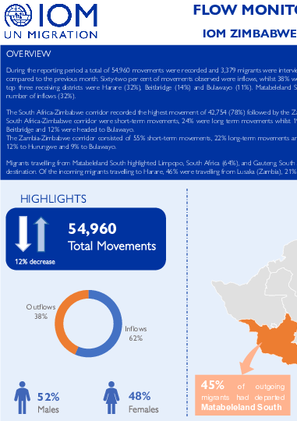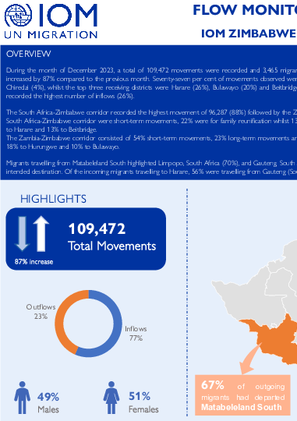-
Countries
-
Data and Analysis
-
Special Focus
-
Crisis Responses
Contact
dtmlibya@iom.int
Location
Libya
Activity
- Mobility Tracking
- Baseline Assessment
Period Covered
Jan 01 2024 -Feb 29 2024
Libya Migrants baseline assessment Round 51
Population Groups
Migrants Present
Survey Methodology
Unit of Analysis Or Observation
Admin Area 2
Admin Area 3
Admin Area 4
Type of Survey or Assessment
Key Informant
Keywords
Geographical Scope Full Coverage
Administrative boundaries with available data
The current dataset covers the following administrative boundaries

Contact
DTM Europe, DTMMediterranean@iom.int
Language
English
Location
Poland
Period Covered
Jan 01 2023
Dec 31 2023
Activity
- Survey
Key findings:
- 20% of respondents live with people with specific needs or serious medical conditions
- Priority needs include: health care services (29%), medication (25%) and mental health support (6%)
- Specific needs* include chronic diseases or serious medical conditions (28%), visual impairment (15%), and difficulty walking (7%)
- Barriers to healthcare include: language barrier (32%), long queues (29%), unavailable services (28%), lack of transport (13%) and lack of documents (9%)
- 65% of respondents pay for healthcare services or medicines

Contact
DTM Libya, DTMLibya@iom.int
Language
English
Location
Libya
Snapshot Date
Apr 06 2024
Activity
- Other
This Rapid Needs Assessment provides a snapshot of the situation of the Sudanese nationals who arrived in the municipality of Tobruk after the onset of conflict in Sudan in April 2023. DTM Libya conducted a brief assessment on 3 - 6 April 2024 to shed light on the situation of Sudanese nationals in the municipality of Tobruk who arrived after the onset of conflict in Sudan in April 2023. While most are coming directly from Sudan and arriving in Alkufra, a minority are traveling from Egypt and arriving in Tobruk.

Contact
DTMMozambique@iom.int
Language
English
Location
Mozambique
Period Covered
Apr 17 2024
Apr 28 2024
Activity
- Mobility Tracking
- Event Tracking
Between 17 to 28 April 2024, sporadic attacks, and fear of attacks by Non-state Armed Groups in Ancuabe and Chiúre triggered the cumulative displacement of 35,948 individuals/8,427 families. The current Movement Alert #107 reports on most recent attacks in southern Cabo Delgado. For more information on displacements between February and March, please see {Emergency Tracking Online Dashboard}.

Contact
Idiam Osorio, iosorio@iom.int
Language
Spanish
Location
Panama
Period Covered
Jan 01 2024
Jan 31 2024
Activity
- Flow Monitoring Survey
- Flow Monitoring
La provincia de Darién se ubica en la frontera este de Panamá, y su territorio forma parte de las rutas migratorias más utilizadas por personas en situación de movilidad humana por las Américas para migrar desde el sur hacia el norte del continente. A su vez, esta ruta es altamente peligrosa por las características geográficas del Parque Nacional Darién y la presencia de crimen organizado. Las personas que la transitan se encuentran expuestas a varios riesgos como la trata de personas, tráfico ilícito, violencia basada en género, diversas formas de explotación y abuso. El uso de estas rutas inseguras para llegar a destinos temporales o finales plantea amenazas para la integridad, dignidad y la vida de las personas migrantes.
Actualmente, Panamá mantiene activa la Operación Flujo Controlado, la cual brinda asistencia humanitaria y traslada diariamente a cientos de personas migrantes a sus Estaciones Temporales de Recepción Migratoria (ETRM) en la provincia de Darién. Las personas ingresan por las comunidades de Bajo Chiquito y Canaán Membrillo, ubicadas en la comarca indígena Emberá Wounaan al interior de la provincia de Darién en Panamá y son trasladadas respectivamente a las diferentes ETRM.
Entre el 01 y el 31 de enero de 2024 se registraron 36.001 personas migrantes ingresando irregularmente por la provincia de Darién, suponiendo un flujo promedio de 1.161 migrantes ingresando diariamente. En diciembre de 2023, el número total de entradas fue de 24.626, lo que muestra un aumento del 46 por ciento comparado con el mes anterior

Contact
DTM Zimbabwe, DTMzimbabwe@iom.int, DTMsupport@iom.int
Language
English
Location
Zimbabwe
Period Covered
Mar 01 2024
Mar 29 2024
Activity
- Flow Monitoring
During the reporting period a total of 58,276 movements were recorded and 2,103 migrants were interviewed across 20 Flow Monitoring Points (FMPs) in Zimbabwe. The total movements recorded increased by 6% compared to the previous month. Sixty-seven per cent of movements observed were inflows, whilst 33% were outflows. The top three sending districts were Beitbridge (55%), Harare (11%) and Chiredzi (8%), whilst the top three receiving districts were Harare (28%), Beitbridge (15%) and Bulawayo (10%). Matabeleland South province recorded the highest number of outflows (57%) whilst Harare province recorded the highest number of inflows (28%). The South Africa-Zimbabwe corridor recorded the highest movement of 52,976 (91%) followed by the Zambia-Zimbabwe corridor which recorded 5,300 (9%) movements. Fifty-six per cent of movements along the South Africa-Zimbabwe corridor were short-term movements, 21% were family reunification movements whilst 19% were long-term economic movements. Of the migrants travelling from South Africa, 19% travelled to Harare, 19% to Beitbridge and 10% were headed to Bulawayo. The Zambia-Zimbabwe corridor consisted of 52% short-term movements, 24% long-term economic movements and 23% family reunification movements. Of the migrants travelling from Zambia, 65% were travelling to Harare, 17% to Hurungwe and 8% to Bulawayo. Migrants travelling from Matabeleland South highlighted Limpopo (72%) and Gauteng, South Africa (26%) as their intended destination.. Of the incoming migrants travelling to Harare, 73% were travelling from Gauteng whilst 27% were travelling from Gauteng province in South Africa.

Contact
DTM Zimbabwe, DTMzimbabwe@iom.int, DTMsupport@iom.int
Language
English
Location
Zimbabwe
Period Covered
Feb 01 2024
Feb 29 2024
Activity
- Flow Monitoring
During the reporting period a total of 54,960 movements were recorded and 3,379 migrants were interviewed across 38 Flow Monitoring Points (FMPs) in Zimbabwe. The total movements recorded decreased by 12% compared to the previous month. Sixty-two per cent of movements observed were inflows, whilst 38% were outflows. The top three sending districts were Beitbridge (40%), Harare (14%) and Chiredzi (9%), whilst the top three receiving districts were Harare (32%), Beitbridge (14%) and Bulawayo (11%). Matabeleland South province recorded the highest number of outflows (45%) whilst Harare province recorded the highest number of inflows (32%). The South Africa-Zimbabwe corridor recorded the highest movement of 42,754 (78%) followed by the Zambia-Zimbabwe corridor which recorded 7,454 (14%) movements. Fifty-two per cent of movements along the South Africa-Zimbabwe corridor were short-term movements, 24% were long term movements whilst 19% were for family reunification. Of the migrants travelling from South Africa, 23% travelled to Harare, 20% to Beitbridge and 12% were headed to Bulawayo. The Zambia-Zimbabwe corridor consisted of 55% short-term movements, 22% long-term movements and 22% family reunification movements. Of the migrants travelling from Zambia, 64% were travelling to Harare, 12% to Hurungwe and 9% to Bulawayo. Migrants travelling from Matabeleland South highlighted Limpopo, South Africa (64%), and Gauteng, South Africa (22%) as their intended destination. Those travelling to Botswana indicated Central (4%) as their intended destination. Of the incoming migrants travelling to Harare, 46% were travelling from Lusaka (Zambia), 21% from Gauteng (South Africa), and 10% from Eastern Cape (South Africa).

Contact
DTM Zimbabwe, DTMzimbabwe@iom.int, DTMsupport@iom.int
Language
English
Location
Zimbabwe
Period Covered
Jan 01 2024
Jan 31 2024
Activity
- Flow Monitoring
During the reporting period a total of 62,339 movements were recorded and 3,811 migrants were interviewed across 38 Flow Monitoring Points (FMPs) in Zimbabwe. The total movements recorded decreased by 43% compared to the previous month. Sixty per cent of movements observed were inflows, whilst 40% were outflows. The top three sending districts were Beitbridge (41%), Harare (15%) and Chiredzi (10%), whilst the top three receiving districts were Harare (36%), Beitbridge (13%) and Bulawayo (9%). Matabeleland South province recorded the highest number of outflows (46%) whilst Harare province recorded the highest number of inflows (36%). The South Africa-Zimbabwe corridor recorded the highest movement of 49,574 (80%) followed by the Zambia-Zimbabwe corridor which recorded 7,975 (13%) movements. Forty-nine per cent of movements along the South Africa-Zimbabwe corridor were short-term movements, 28% were long term movements whilst 17% were for family reunification. Of the migrants travelling from South Africa, 30% travelled to Harare, 19% to Beitbridge and 11% were headed to Bulawayo. The Zambia-Zimbabwe corridor consisted of 58% short-term movements, 21% long-term movements and 20% family reunification movements. Of the migrants travelling from Zambia, 64% were travelling to Harare, 14% to Hurungwe and 7% to Gweru. Migrants travelling from Matabeleland South highlighted Limpopo, South Africa (51%), and Gauteng, South Africa (37%) as their intended destination. Those travelling to Botswana indicated Francistown (3%) as their intended destination. Of the incoming migrants travelling to Harare, 33% were travelling from Lusaka (Zambia), 28% from Gauteng (South Africa), and 14% from Eastern Cape (South Africa).
During the month of December 2023, a total of 109,472 movements were recorded and 3,465 migrants were interviewed across 38 Flow Monitoring Points (FMPs) in Zimbabwe. The total movements recorded increased by 87% compared to the previous month. Seventy-seven per cent of movements observed were inflows, whilst 23% were outflows. The top three sending districts were Beitbridge (64%), Harare (12%) and Chiredzi (4%), whilst the top three receiving districts were Harare (26%), Bulawayo (20%) and Beitbridge (11%). Matabeleland South province recorded the highest number of outflows (67%) whilst Harare province recorded the highest number of inflows (26%). The South Africa-Zimbabwe corridor recorded the highest movement of 96,287 (88%) followed by the Zambia-Zimbabwe corridor which recorded 8,588 (8%) movements. Sixty-two per cent of movements along the South Africa-Zimbabwe corridor were short-term movements, 22% were for family reunification whilst 13% were long-term movements. Of the migrants travelling from South Africa, 22% were going to Bulawayo, 22% to Harare and 13% to Beitbridge. The Zambia-Zimbabwe corridor consisted of 54% short-term movements, 23% long-term movements and 21% family reunification movements. Of the migrants travelling from Zambia, 55% were travelling to Harare, 18% to Hurungwe and 10% to Bulawayo. Migrants travelling from Matabeleland South highlighted Limpopo, South Africa (70%), and Gauteng, South Africa (18%) as their intended destination. Those travelling to Botswana indicated Central Province (4%) as their intended destination. Of the incoming migrants travelling to Harare, 56% were travelling from Gauteng (South Africa), 24% from Lusaka (Zambia), and 5% from Western Cape (South Africa).

Contact
DTM Zimbabwe, DTMzimbabwe@iom.int, DTMsupport@iom.int
Language
English
Location
Zimbabwe
Period Covered
Nov 01 2023
Nov 30 2023
Activity
- Flow Monitoring
During the month of November 2023, a total of 58,669 movements were recorded and 3,679 migrants were interviewed across 38 Flow Monitoring Points (FMPs) in Zimbabwe. The total movements recorded increased by 0.2% compared to the previous month. Sixty-eight per cent of movements observed were inflows, whilst 32% were outflows. The top three sending districts were Beitbridge (47%), Harare (16%) and Chiredzi (7%), whilst the top three receiving districts were Harare (30%), Beitbridge (12%) and Bulawayo (10%). Matabeleland South province recorded the highest number of outflows (52%) whilst Harare province recorded the highest number of inflows (31%). The South Africa-Zimbabwe corridor recorded the highest movement of 46,911 (80%) followed by the Zambia-Zimbabwe corridor which recorded 7,272 (12%) movements. Fifty-nine per cent of movements along the South Africa-Zimbabwe corridor were short-term movements, 20% were for family reunification whilst 20% were long-term economic movements. Of the migrants travelling from South Africa, 25% were going to Harare, 15% to Beitbridge and 9% to Bulawayo. The Zambia-Zimbabwe corridor consisted of 53% short-term movements, 24% family reunification movements and 22% long-term movements. Of the migrants travelling from Zambia, 54% were travelling to Harare, 15% to Bulawayo and 13% to Hurungwe. Migrants travelling from Matabeleland South highlighted Limpopo, South Africa (69%), and Gauteng, South Africa (19%) as their intended destination. Those travelling to Botswana indicated Central Province (3%) as their intended destination. Of the incoming migrants travelling to Harare, 35% were travelling from Gauteng (South Africa), 30% from Lusaka (Zambia), and 13% from Eastern Cape (South Africa).
